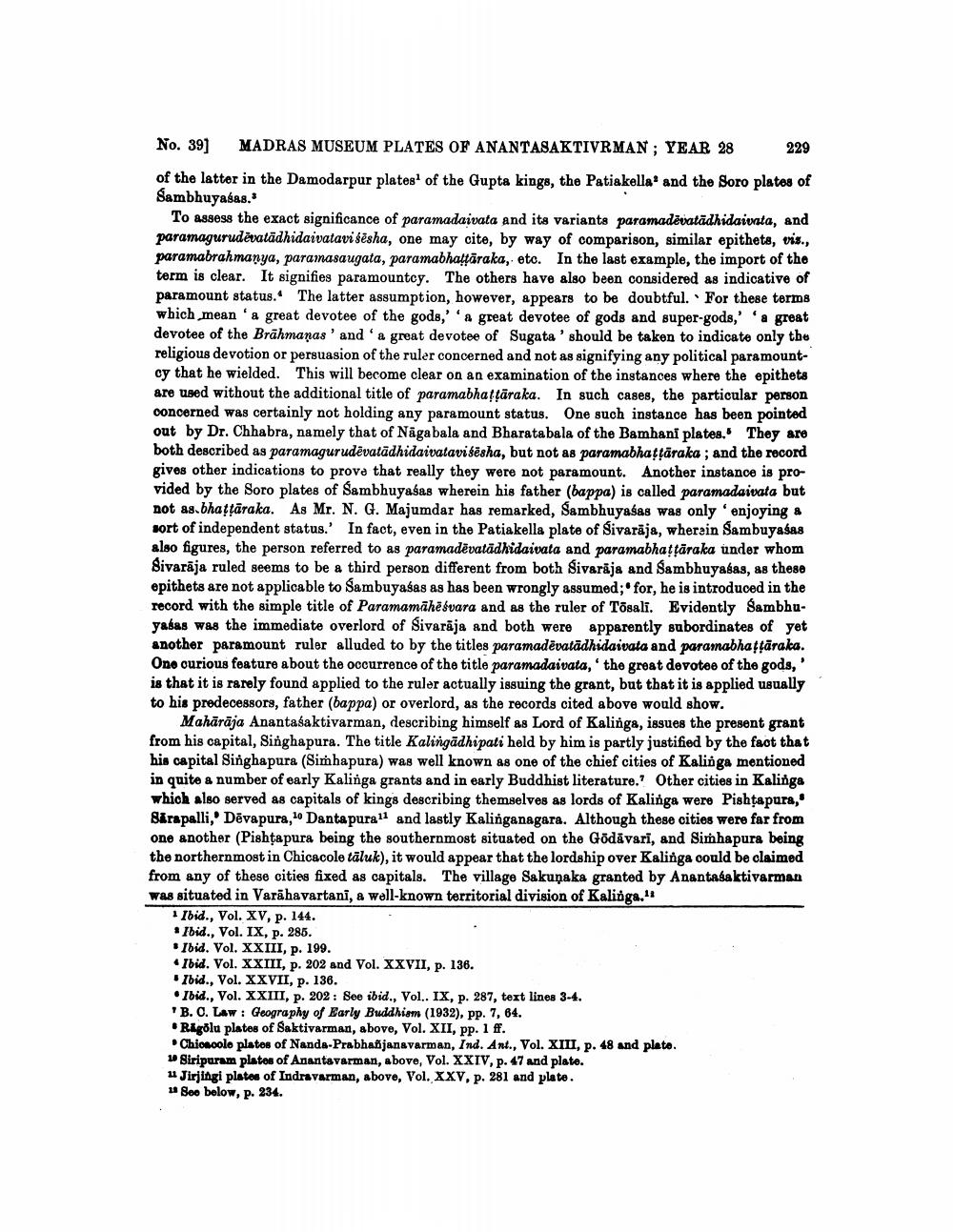________________
No. 39) MADRAS MUSEUM PLATES OF ANANTASAKTIVRMAN ; YEAR 28 229 of the latter in the Damodarpur plates of the Gupta kings, the Patiakella and the Soro plates of Sambhuyasas.
To assess the exact significance of paramadaivata and its variants paramadēvatādhidaivata, and paramagurudevatädhidaivatavi cesha, one may cite, by way of comparison, similar epithets, vis., paramabrahmanya, paramasaugata, paramabhaltāraka, etc. In the last example, the import of the term is clear. It signifies paramountcy. The others have also been considered as indicative of paramount status. The latter assumption, however, appears to be doubtful. For these terms which mean'a great devotee of the gods,' a great devotee of gods and super-gods,' 'a great devotee of the Brāhmanas' and ' a great devotee of Sugata 'should be taken to indicate only the religious devotion or persuasion of the ruler concerned and not as signifying any political paramountcy that he wielded. This will become clear on an examination of the instances where the epithets are used without the additional title of paramabhattāraka. In such cases, the particular person concerned was certainly not holding any paramount status. One such instance has been pointed out by Dr. Chhabra, namely that of Nägabala and Bharatabala of the Bamhani plates. They are both described as paramagurudevatādhidaivatavi śēsha, but not as paramabhattāraka ; and the record gives other indications to prove that really they were not paramount. Another instance is provided by the Soro plates of Sambhuyaśas wherein his father (bappa) is called paramadaivata but not as bhattāraka. As Mr. N. G. Majumdar has remarked, Sambhuyaśas was only enjoying a sort of independent status.' In fact, even in the Patiakella plate of Sivaraja, wherein Sambuyasas also figures, the person referred to as paramadēvatādhidaivata and paramabhatfaraka under whom Sivarāja ruled seems to be a third person different from both Sivarāja and Sambhuyabas, as these epithets are not applicable to Sambuyasas as has been wrongly assumed;" for, he is introduced in the record with the simple title of Paramamāhēsvara and as the ruler of Tõsali. Evidently Sambhuyabas was the immediato overlord of Sivarāja and both were apparently subordinates of yet another paramount ruler alluded to by the titles paramadevatādhidaivata and paramabhaffäraka. Ono ourious foature about the occurrence of the title paramadaivata,' the great devotos of the gods, is that it is rarely found applied to the ruler actually issuing the grant, but that it is applied usually to his predecessors, father (bappa) or overlord, as the records cited above would show.
Mahārāja Anantasaktivarman, describing himself as Lord of Kalinga, issues the present grant from his capital, Singhapura. The title Kalingādhipati held by him is partly justified by the fact that his capital Singhapura (Simhapura) was well known as one of the chief cities of Kalinga mentioned in quite a number of early Kalinga grants and in early Buddhist literature. Other cities in Kalinga which also served as capitals of kings describing themselves as lords of Kalinga were Pishtapura," Sirapalli, Dēvapura, Dantapural and lastly Kalinganagara. Although these cities were far from one another (Pishtapura being the southernmost situated on the Godavari, and Simhapura being the northernmost in Chicacole täluk), it would appear that the lordship over Kalinga oould be claimed from any of these cities fixed as capitals. The village Sakunaka granted by Anantasaktivarman was situated in Varähavartani, a well-known territorial division of Kalioga.
1 Ibid., Vol. XV, p. 144. . Ibid., Vol. IX, p. 285. • Ibid. Vol. XXIII, p. 199. • Ibid. Vol. XXIII, p. 202 and Vol. XXVII, p. 136. . Ibid., Vol. XXVII, p. 136.
Ibid., Vol. XXIII, p. 202: See ibid., Vol.. IX, p. 287, text lines 3-4. B. O. Law: Geography of Early Buddhism (1932), pp. 7, 64. Regola plates of Saktivarman, above, Vol. XII, pp. 1 ff.
Chioncolo plates of Nanda-Prabhañjanavarman, Ind. Ant., Vol. XIII, p. 48 and plato. 1 Siripuram platos of Anantavarman, above, Vol. XXIV, p. 47 and plato. u Jirjingi plates of Indravarman, above, Vol. XXV, p. 281 and plate.
See below, p. 234.




